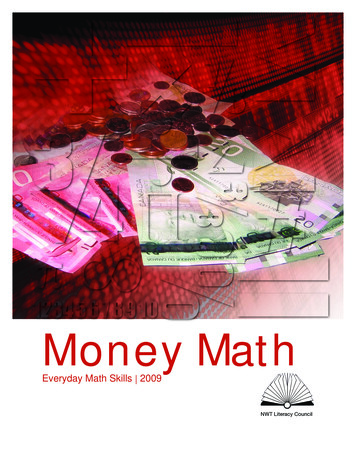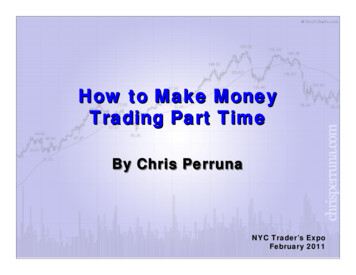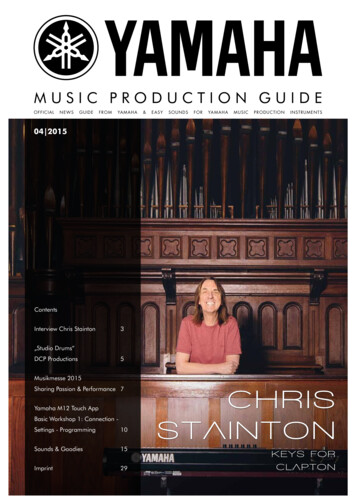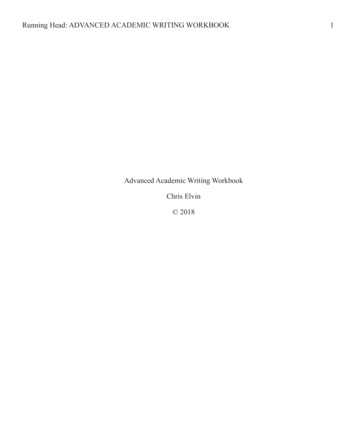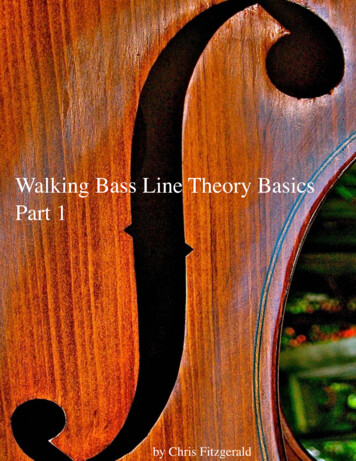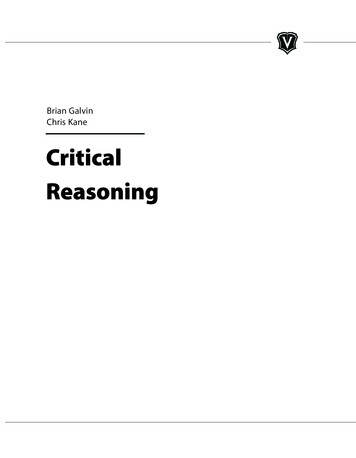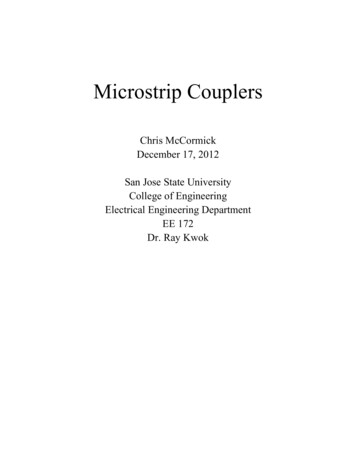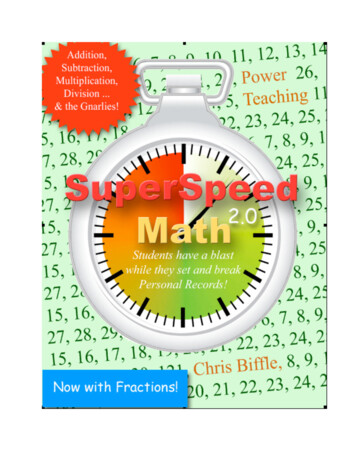
Transcription
SuperSpeed Math, copyright Chris Biffle 2007SuperSpeed Math 2.0Addition, Subtraction, Multiplication, Division And the Gnarlies!-- Special 2.0 Bonus: Fractions!!!Chris Teaching.com2
SuperSpeed Math, copyright Chris Biffle 20073ContentsIntroductionThe SuperSpeed Math GridsHow To Play SuperSpeed MathAdjusting For Stronger and Weaker LearnersOne on One TutorialsThe GnarliesSuperSpeed AdditionSuperSpeed SubtractionSuperSpeed MultiplicationSuperSpeed DivisionSuperSpeed GnarliesSuperSpeed FractionsSuperSpeed Personal Record Stars461214161721252933374246
SuperSpeed Math, copyright Chris Biffle 2007Other SuperSpeed Learning GamesSuperSpeed NumbersSuperSpeed Letters & PhonicsSuperSpeed 100 Sight WordsSuperSpeed 1000 Sight WordsFor more information about SuperSpeed and Whole Brain Teachingproducts go toWholeBrainTeaching.comor contactChris BiffleDirector, Whole Brain TeachingChrisBiffle@WholeBrainTeaching.comNo part of this document, print or electronic, may be offered for salewithout the express written permission of the author, Chris Biffle.4
SuperSpeed Math, copyright Chris Biffle 20075IntroductionWhole Brain Teachingis a grass roots education reformorganization founded by three instructors (Chris Biffle, Jay Vanderfin,Chris Rekstad) in 1999. Since that time, we have presented freeteaching seminars to over 20,000 educators representing over 700,000students. A calendar of our teaching conferences is available atWholeBrainTeaching.com.Videos illustrating our instructional strategies are available at:www.YouTube.com/ChrisBiffleIn addition to offering education seminars, we also develop lowcost teaching materials focused on core knowledge (state standards) andbasic skills (reading, writing, critical thinking and math.) Central to ourapproach is a great deal of educational tomfoolery which produces someof the sweetest sounds teachers ever hear, on-task laughter.SuperSpeed Math is a lively, entertaining game designed to teachbeginning learners of any age math facts in addition, subtraction,multiplication, division and fractions using the numbers from 0-10.Versions of this game have been successfully classroom tested bythousands of students since 1999.Because it begins with the simplest arithmetic operations andcontinues through the most difficult, SuperSpeed Math is appropriate forlearners from kindergarten through 12th grade. The game also adaptssuperbly to the needs of English learners, including adults who aretaking a beginning math course.If your students play SuperSpeed Math for only a few minutes,several times a week, you’ll see substantial improvements in overallmathematics accuracy; gains of 20% within a month are not uncommon.
SuperSpeed Math, copyright Chris Biffle 2007SuperSpeed Math is so entertaining that teachers have used it as areward for good behavior! Students work hard in class, to gain theprivilege of playing SuperSpeed!!6
SuperSpeed Math, copyright Chris Biffle 20077The SuperSpeed GridsAs a representative of our approach, we’ll focus the following onSuperSpeed Addition. The other math games, subtraction,multiplication, division and fractions, follow the same format. (You’lllearn more about Gnarlies, the most common math errors, in a fewmoments.)Except for “carrying”, all addition operations involve nothingmore complex than adding the numbers from 0-10. And yet in everyclass, students make countless addition errors. Why? The reason isobvious: students have too little addition practice. Your class will not beable to flawlessly total columns of numbers until they can master addingtwo numbers. The more rapidly students can add (and perform the otherthree math operations, subtraction, multiplication and division), thegreater their mathematics fluency and confidenceSuperSpeed Addition (like the rest of SuperSpeed Math) is playedwith a grid of problems. There are only two levels, termed, appropriatelyenough, Level 1 and Level 2. Level 1 is easier; Level 2 is harder.Each level is composed of a test and a set of answers.Students work in pairs. One student orally takes the test while theother student checks the answers.Look at the next page to see the first three rows of the test andanswer grid from Level 1 of SuperSpeed Addition.
SuperSpeed Math, copyright Chris Biffle 20078Here are the first three rows of the test and the answer grid fromLevel 1 for SuperSpeed Addition. Note that the test grid is identical tothe answer grid, except, of course, that it lacks answers.Level 1: ADDITION TestABCDEFGHIHK10 00 10 20 30 40 50 60 70 80 90 1021 02 03 04 05 06 07 08 09 010 011 01 11 21 31 41 51 61 71 81 911 10 113Level 1: ADDITION Answers123ABCDEFGHIHK0 001 011 120 112 021 230 223 031 340 334 041 450 445 051 560 556 061 670 667 071 780 778 081 890 889 091 9100 9910 0101 10110 101011 0111 1112On the next page you’ll find, in reduced form, the entire Answergrid for Level 1.
SuperSpeed Math, copyright Chris Biffle 20079Here, shrunk to fit this page, is the Answer grid for Level 1.1234567891011ABCDEFGHIHK0 001 011 234 152 689 2115 384 9135 8136 9159 7160 112 021 345 162 7910 2126 394 10145 9146 101610 7170 223 031 456 172 8103 367 3105 495 10157 6138 8160 334 041 567 182 9113 478 3116 4106 5118 6148 9170 445 051 678 192 10123 589 3127 4117 5129 6158 10180 556 061 789 1103 253 6910 3138 4128 51310 6169 8170 667 071 8910 1114 263 7104 489 4139 5147 71410 8180 778 081 9102 245 273 8114 5910 41410 5157 8159 9180 889 091 10112 356 283 9124 6105 5106 6127 9169 10190 9910 0102 132 467 293 10134 7115 6116 7137 101710 9190 10101 123 142 578 2104 374 8125 7126 8148 71510 1020Every possible combination of addition problems 0-10 is includedin numerical order. The problems move from simpler, adding 0, 1, 2, 3to more complex, adding 6, 7, 8, 9. Note the shaded boxes of the 15problems, the Gnarly 15, near the end.
SuperSpeed Math, copyright Chris Biffle 200710The Gnarlies have been identified by college math instructors asthe most common addition errors. The closer pairs of numbers approach10 (6 7, 8 9, etc.), the more likely students are to make an additionerror. With one exception. Students seem to make fewer errors whenthey are adding doubles, 6 6, 7 7, 8 8 and 9 9.Spend some time helping yours students master the Gnarlies there are only 15 in addition (and somewhat more in the other mathoperations.) When they learn there are only 15 problems that cause themajority of addition errors in college, they’ll be motivated to focusespecially hard on these challenging pairs. (Think about that. There areonly 15 addition problems that cause the majority of difficulty in highergrades let’s rid the world of the Gnarlies!)On the next page, you’ll find the first three rows of the Level 2Addition grids.
SuperSpeed Math, copyright Chris Biffle 200711Here are the first three rows of the Level 2 Addition grids.Level 2: ADDITION TestB0 1C8 6D3 6E7 5F4 4G7 8H0 7I1A7 96 4J10 5K9 628 46 78 88 510 86 86 26 94 78 73 831 22 87 65 8 10 99 10 10 36 59 72 17 1Level 2: ADDITION Test123A7 9168 4121 23B0 116 7132 810C8 6148 8167 613D3 698 5135 1015E7 51210 8188 917F4 486 8149 1019G7 8156 2810 313H0 776 9156 511I6 4104 7119 716J10 5158 7152 13K9 6153 8117 18Level 2 presents the same 121 addition problems as Level 1 but inrandom order and the Gnarlies are much closer to the beginning. Whenstudents master Level 2, they have mastered all the basic addition facts
SuperSpeed Math, copyright Chris Biffle 2007and will have had plenty of practice adding the most troublesome pairsof numbers.One final, and important note. When you hand out these grids toyour students, print each Level on one page, back to back. Level 1 Testis on one side of the page; Level 1 Answers is on the other side of thesame sheet. Same for Level 2 Test and Answers.12
SuperSpeed Math, copyright Chris Biffle 200713How To Play SuperSpeed MathPlaying SuperSpeed Math is simple. We’ll continue to useSuperSpeed Addition as our example.The game is played in 60 second time periods, with studentsworking in pairs. As quickly as possible, one student orally says andsolves the questions on the Test; the other student checks the Answers.(It is very important the the student taking the test, say the problem andthe answer, so that problem and answer is linked in the student’s brain.)Arrange your class in groups of twos. If you have an odd numberof students, you will pair with the extra kid. Without telling your pupils,be sure that a weaker learner is always paired with a stronger learner.Each student gets two 60 second attempts. Thus, if Juana andPaul are playing, Juana, looking at the test sheet, orally solves as manyaddition problems as possible in 60 seconds while Paul, looking at theanswer sheet, orally corrects her mistakes. Then, Juana gets a second tryand attempts to break her previous record. When Juana is finished, Paulgets two 60 second attempts; Juana orally corrects his mistakes.The goal is for each player to solve as many math problems aspossible in 60 seconds, setting and breaking personal records. Juana isnot trying to beat Paul’s record or vice versa. Juana’s only focus is onimproving her fastest time. Students are racing against themselves which is the fairest, most exciting race of all.Emphasize to your class that “helpsies” is not only allowed butencouraged. If Juana doesn’t know an answer, Paul immediately helpsher. Players, because they are slowed down when they are corrected,soon understand that studying the problems on the answer sheet thatcause them the most difficulty is the best way to improve their personalrecords.
SuperSpeed Math, copyright Chris Biffle 200714Only three additional rules needs to be added.1. Before players begin they should mark a goal on the math grid; thisindicates the problem they hope to complete by the end of 60 seconds.Goal setting is not only a crucial feature in SuperSpeed it certainlymakes the game even more exciting, but also, obviously, an importantcomponent in education and life.2. When players break personal records, they should place their scoreinside a personal record star on page 46. Thus, for example, if Juanafinishes problem C in row 8, she would write C8 in her personal recordstar. You will be surprised at how much your students enjoy creating,and sharing!, a visual record of their own achievements.2. When students break their goal, the next time they play, they start onerow down from their previous starting point. For example, let’s sayJuana starts at A1 on the test grid (the first problem on the first line).She gets to D4 in 60 seconds (the fourth problem on the fourth row.)She tries again starting at A1 and reaches D6, breaking her record. Thenext time she plays, she doesn’t start at A1; she starts one row down atB1. In this way, students advance through all the problems. If theyreach the last problem before time is up, they go back up to the top ofpage, or go on to the next Level.Now, here is a very important point. Students love to play SuperSpeed Mathbecause they love to strive for goals and to set and break personal records. Playersare never competing against each other, but against their own previous best effort.Thus, the learning objective is set at exactly the right level, no matter a player’sability. The only standard Juana must exceed is the one she set for herself the lasttime she played. Until you try SuperSpeed Math in class, you won’t believe theenthusiasm your students will have while playing. Students love the feeling ofbeing record breakers, and the unique structure of SuperSpeed Math gives themthis feeling over and over.
SuperSpeed Math, copyright Chris Biffle 200715Advanced RulesWhen students have mastered the simple rules above, we strongly suggestthey use the following for missed problems.1. When a player is taking a the test, she uses a pencil as a pointer.Whenever she misses a problem, she places a dot on the problem missed.2. When a player misses a problem, her partner tells her the correct answerand says, “Go back two!” Thus, if Juana misses the problem at C8, shemust go back two problems to A8. This forces her to remember thecorrect answer! The dotted problems are her personal gnarlies.3. If a player, despite missing problems, breaks her record, she, as before,starts one row down.4. When the instructor is satisfied that individual students, or the entireclass, are making adequate progress, then students work on GnarliesOnly.These would include both the shaded problems and the personalGnarlies that the individual student has dotted. The highest goal ofSuperSpeed Math is for students to identify and master their own,personalized set of Gnarlies. When working on Gnarlies Only, studentssimply see how many they can answer correctly in a minute; there is nomoving down a row because the Gnarlies are scattered all over the page.As an example of these new rules, Juana using a pencil, puts a dot on eachproblem Paul tells her she missed. At each error, Paul tells Juana the correctanswer and says, “go back two!” Every dotted problem is one of Juana’s personalgnarlies. If Juana breaks her old record, she begins one row down from herprevious starting point.When the instructor is satisfied that Juana is making satisfactory progress, sheplays Gnarlies Only, seeing how many dotted and shaded Gnarlies she can solvecorrectly in a minute. As before, Paul has an Answer sheet and tells her to go backtwo whenever she misses a problem.
SuperSpeed Math, copyright Chris Biffle 200716Adjusting For Stronger and Weaker LearnersLet’s say that Juana is a math whiz and Paul isn’t. If Juana cansolve 121 addition problems in 60 seconds, going across the rows ofLevel 1, then the next time she plays she goes down the columns. Asyou remember from Level 1, the answers only fall in counting orderwhen going across rows.If Juana can answer all the Level 1 addition problems going downthe columns, then when she gets to the end of the grid, she simp
SuperSpeed Math, copyright Chris Biffle 2007 7 The SuperSpeed Grids As a representative of our approach, we’ll focus the following on SuperSpeed Addition. The other math games, subtraction, multiplication, division and fractions, follow the same format. (You’ll learn more about Gnarlies, the most common math errors, in a few moments.)File Size: 1MBPage Count: 46

